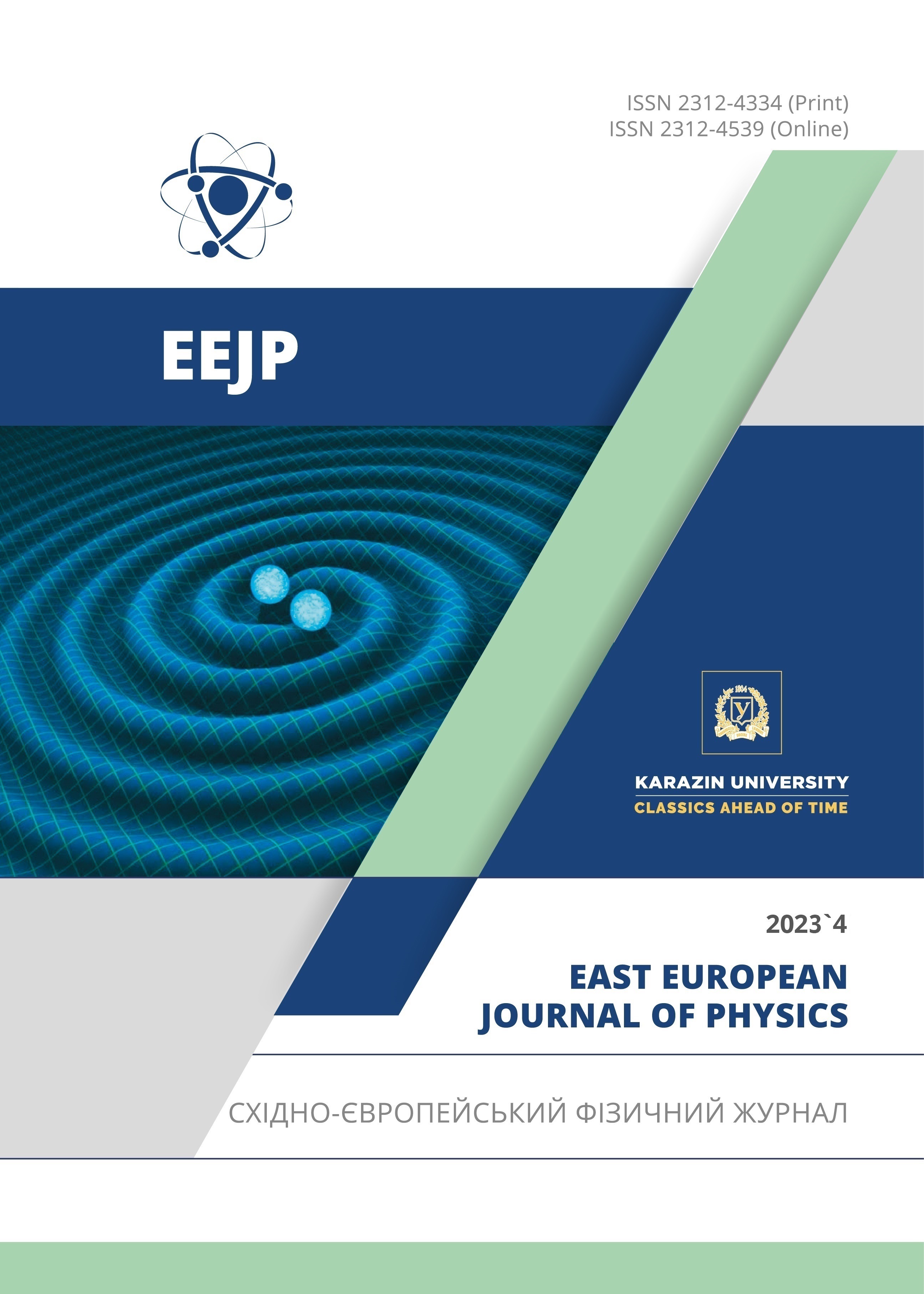Dangerous Bonds Individual of Hydrogenated Amorphous Silicon and Defect Absorption Spectra
Abstract
In this work, defect absorption spectra for defects characteristic of hydrogenated amorphous silicon are theoretically studied. It is shown that in order to determine defect absorption spectra using the Kubo-Greenwood formula, the indefinite integral in this formula must be written in a certain form. It was discovered that electronic transitions involving defect states are divided into two parts depending on the energy of absorbed photons. The values of the partial defect absorption spectrum at low energies of absorbed photons have almost no effect on the overall defect absorption spectrum. It has been established that the main role in determining the defect absorption spectrum is played by partial spectra determined by optical transitions of electrons between allowed bands and defects. It is shown that with a power-law distribution of the density of electronic states in allowed bands, the spectra of optical transitions between them and defects do not depend on the value of this power.
Downloads
References
V.I. Fistul, Introduction to semiconductor physics, (Vysshaya shkola, Moscow, 1984). (in Russian)
M.S. Ablova, G.S. Kulikov, and S.K. Persheev, “Metastable states of undoped amorphous hydrogenated, created by γ irradiation,” FTP, 36(8), 1001-1003 (2002). (in Russian)
M. Gunes, and Ch.R. Wronski, “Differences in densities of charged defect states and kinetics of Staebler-Wronski effect in undoped (nontrinsic) hydrogenated amorphous silicon thin films,” J. Appl. Phys. 81(8), 3526-3536 (1997). https://doi.org/10.1063/1.365000
R.G. Ikramov, A.A. Mamaxanov, M.A. Nuriddinova, R.M. Jalolov, Kh.A. Muminov, and B.Q. Sultonov, “Calculation of the interband absorption spectrum of amorphous semiconductors using the Kubo-Greenwood formula,” Journal of Applied Science and Engineering, 25(5), 767-772 (2022). http://jase.tku.edu.tw/articles/jase-202210-25-5-0007
G.D. Cody, “Hydrogenated Amorphous Silicon, Part B, Optical Properties,” in: Semiconductors and Semimetals, vol. 21, edited by J.I. Pankove, (Academic Press Inc., Orlando, 1984).
S.K. O’Leary, “On the relationship between the distribution of electronic states and the optical absorption spectrum in amorphous semiconductors,” Solid State Commun. 109, 589–594 (1999). https://doi.org/10.1016/S0038-1098(98)00605-X
S. Zainobidinov, R.G. Ikramov, and R.M. Zhalalov, “Urbach energy and tails of the density of states of amorphous semiconductors,” Journal of Applied Spectroscopy, 78(2), 223-227 (2011). https://doi.org/10.1007/s10812-011-9450-9
R.G. Ikramov. “Distribution function of electron states of dangling bonds in amorphous semiconductors,” Estestv. Tekhn. Nauki, 6, 53 (2007) (in Russian).
F. Orapunt, and S.K. O'Leary, “A quantitative characterization of the optical absorption spectrum associated with hydrogenated amorphous silicon,” Mater Electron. 20, 1033-1038 (2009). https://doi.org/10.1007/s10854-008-9825-8
S. Zainobidinov, R.G. Ikramov, R.M. Zhalalov, and M.A. Nuritdinova, “Distribution of electron density of states in allowed bands and interband absorption in amorphous semiconductors,” Optics and spectroscopy, 110(5), 762–766 (2011). https://doi.org/10.1134/S0030400X11030271
R.G. Ikramov, M.A. Nuriddinova, and Kh.A. Muminov, “Calculation of the density of electronic states in the valence band from the experimental spectrum of interband absorption of amorphous semiconductors,” Journal of Applied Spectroscopy, 88(3), 378 382 (2021). https://doi.org/10.1007/s10812-021-01200-9
Copyright (c) 2023 Rustamjon G. Ikramov, Khurshidbek A. Muminov, Mashkhura A. Nuritdinova, Bobur Q. Sutonov, Oybek T. Kholmirzayev

This work is licensed under a Creative Commons Attribution 4.0 International License.
Authors who publish with this journal agree to the following terms:
- Authors retain copyright and grant the journal right of first publication with the work simultaneously licensed under a Creative Commons Attribution License that allows others to share the work with an acknowledgment of the work's authorship and initial publication in this journal.
- Authors are able to enter into separate, additional contractual arrangements for the non-exclusive distribution of the journal's published version of the work (e.g., post it to an institutional repository or publish it in a book), with an acknowledgment of its initial publication in this journal.
- Authors are permitted and encouraged to post their work online (e.g., in institutional repositories or on their website) prior to and during the submission process, as it can lead to productive exchanges, as well as earlier and greater citation of published work (See The Effect of Open Access).








